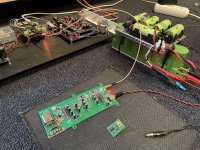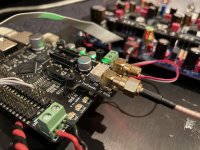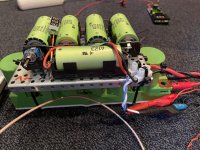@phofman,
Why bother with RPi GPIO bus at all for most streaming audio purposes? IMHO, RPi USB is easier to clean up. Its also easier to physically distance a dac from all the radiated EMI/RFI.
Why bother with USB? I moved away from USB and doubt I would go back. I can certainly see the benefit of the physical distance. That is achievable in other ways.
However you are adding two steps of conversion, both which often add a lot of everything. Including Jitter. I have played around with the JLsounds board (best sounding board I tried) and the Amanero (more recently - to confirm my bias against USB rather than XMOS). However I2S has always been subjectively better.
I much prefer the HDMI I2S solution. 2x Less fundamental signal conversion. Simpler. Feels like a much more focused solution. The HDMI 2.1 spec cables are also so highly specified, to deal with up to 48Gbps, that it pretty much kills the point of audiophile cables and it meets our needs whilst sleeping.
USB feels apt for consumer products, as it provides the ability to access a much wider eco-system. However if you can control your connections from source to DAC, I don't see why you would use it.
@sebbyp, Certain forum members tend to be quick to start name calling (i.e. 'scammer'). To my reading of the rules it a violation. The obvious purpose of the violation is to demean the character of anyone who dares to disagree and put observation before simplified theory.
Thanks Mark. Don't go anywhere, I very much enjoy your posts.
@phofman,
Why bother with RPi GPIO bus at all for most streaming audio purposes? IMHO, RPi USB is easier to clean up. Its also easier to physically distance a dac from all the radiated EMI/RFI.
Each method has its pros and cons. USB is typically isolated on the I2S bus as USB2 isolators are still quite expensive. Clocks are required by both. For embedding the SBC with the DAC I would consider I2S a better fit as it's usually cheaper. IMO neither is a universally preferred method, each has its place.
They sure do (i.e. "You on the other hand are trying to lure in suckers:", "Only one troll around here, one too many.").@sebbyp, Certain forum members tend to be quick to start name calling (i.e. 'scammer'). To my reading of the rules it a violation. The obvious purpose of the violation is to demean the character of anyone who dares to disagree and put observation before simplified theory.
P.S. The Uptone Etherregen EtherREGEN – UpTone Audio is one of those shameless scams intended for those audiophiles with deep pockets and flat parietal lobe.
Apparently you have never tested an Etherregen yourself.
But you do have an opinion, bravo!
The reason why a device like the etherregen has merits for audio is that it blocks common mode noise into the audio chain.
This common mode noise is generated everywhere in the ethernet chain, mostly by the used smps on modem and switches.
Data conversion in a dac is very susceptible for this noise.
The reason why a device like the etherregen has merits for audio is that it blocks common mode noise into the audio chain.
This common mode noise is generated everywhere in the ethernet chain, mostly by the used smps on modem and switches.
Heard of optical fibre?
Yet another Ethernet/networking expert, bravo!
Still waiting for an answer about the TCP bit perfect transfer, no hope for a response.
I’ve already replied to you on this. If you don’t understand, I fear a more detailed answer won’t help.
E
An excellent suggestion. Added benefit, to the true isolation, the requirements are far higher in fibre for data transmission. Especially if you looked at 10gbe or even 100gbe.
Heard of optical fibre?
An excellent suggestion. Added benefit, to the true isolation, the requirements are far higher in fibre for data transmission. Especially if you looked at 10gbe or even 100gbe.
Heard of optical fibre?
Yes and also tried it.
SinePi V8.0 User's manual
SinePi V8.0 User's manual attached below
SinePiV8.0 by Ian, on Flickr
Ian
SinePi V8.0 User's manual attached below
An externally hosted image should be here but it was not working when we last tested it.
SinePiV8.0 by Ian, on Flickr
Ian
Attachments
Thanks Ian, for letting me try the SinePi 
I had it powered for a week or so to make sure it is burned in.
Build quality is great as we are used from your products.
I have been doing some first listening with the same setup I have been using for all the clock tests. This is not the top-top-top possible version of a setup. The idea behind is, that also in a somewhat more normal DAC situation things should make a difference (or not)
I will write some more on my Blog Site later, but just wanted to give this first impression. Which of course is my personal experience in my system.
Long story short, besides the mechanically benefit of the SinePi versus the sine-square board from Andrea, it also sounds a little bit more spatial and let the instruments and voices tone a tad more natural. I have been going back and forward several times and it was recognizable on different tracks. The difference is small. I cannot repeat enough that this is not about high-end versus shower radio. Both are fantastic and I could easily live with both. Like so often, if by some magic the sine/square converters would be changed without me knowing and I would listen to my setup a few days later I most likely would not jump up like "what the heck happened !" but instead just enjoy the music
But as it is in our hobby, if in a direct comparison you lean toward option XYZ, you just let that option sit in the final setup and take any further tweaking from there. And that is also the case with the SinePi. Now it is there it can stay.
Some pictures of the setup. As you can see I made a poor mans A123 Battery supply with the EATON Ultracapacitor Bank to power the Andrea 5.6MHz clock (In the background you might notice a Neutron 3 11MHz clock - in my blog later more)
I could not yet try if there is a cross influence when the 6,1MHz clock is connected to the other SMA connector, for the simple reason I cannot get the 6,1MHz clock to work. Andrea is already trying to help me out (Thanks for support Andrea !) so hopefully that will be tested as well soon.
I had it powered for a week or so to make sure it is burned in.
Build quality is great as we are used from your products.
I have been doing some first listening with the same setup I have been using for all the clock tests. This is not the top-top-top possible version of a setup. The idea behind is, that also in a somewhat more normal DAC situation things should make a difference (or not)
I will write some more on my Blog Site later, but just wanted to give this first impression. Which of course is my personal experience in my system.
Long story short, besides the mechanically benefit of the SinePi versus the sine-square board from Andrea, it also sounds a little bit more spatial and let the instruments and voices tone a tad more natural. I have been going back and forward several times and it was recognizable on different tracks. The difference is small. I cannot repeat enough that this is not about high-end versus shower radio. Both are fantastic and I could easily live with both. Like so often, if by some magic the sine/square converters would be changed without me knowing and I would listen to my setup a few days later I most likely would not jump up like "what the heck happened !" but instead just enjoy the music
But as it is in our hobby, if in a direct comparison you lean toward option XYZ, you just let that option sit in the final setup and take any further tweaking from there. And that is also the case with the SinePi. Now it is there it can stay.
Some pictures of the setup. As you can see I made a poor mans A123 Battery supply with the EATON Ultracapacitor Bank to power the Andrea 5.6MHz clock (In the background you might notice a Neutron 3 11MHz clock - in my blog later more)
I could not yet try if there is a cross influence when the 6,1MHz clock is connected to the other SMA connector, for the simple reason I cannot get the 6,1MHz clock to work. Andrea is already trying to help me out (Thanks for support Andrea !) so hopefully that will be tested as well soon.
Attachments
SinePi listening tests
Thanks for the feed back. I see Drixo clock with SOTA power supply, FIFOPi, no ReclockPi into DDDAC. May I ask what is downstream electronics and speakers? Just curious. Your test makes sense as it's consistent with your other clock tests. Then I think we'll hear from SuperSurfer which may be in his main system and those two plus Ian's report will give a comprehensive set of feedback.
Thanks for the feed back. I see Drixo clock with SOTA power supply, FIFOPi, no ReclockPi into DDDAC. May I ask what is downstream electronics and speakers? Just curious. Your test makes sense as it's consistent with your other clock tests. Then I think we'll hear from SuperSurfer which may be in his main system and those two plus Ian's report will give a comprehensive set of feedback.
- Home
- Source & Line
- Digital Line Level
- Asynchronous I2S FIFO project, an ultimate weapon to fight the jitter


